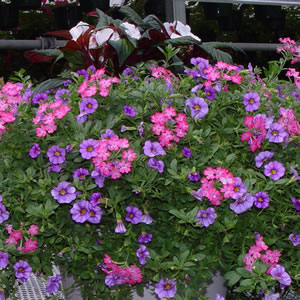Healthy & Happy Hanging Flower Baskets
 Improve the allure of your home by dressing up your walkway, porch and terrace with hanging flower baskets that boast springtime color and fantastic foliage. Although hanging flower baskets liven up small and drab spaces, they seem to be harder to keep alive since they are confined in small pots and hanging in the drying air all season long. However, with a little bit of dedication and the right amount of sun, water and fertilizer, your hanging basket will last well into the fall. Keep your plants healthy and happy by following these helpful guidelines.
Improve the allure of your home by dressing up your walkway, porch and terrace with hanging flower baskets that boast springtime color and fantastic foliage. Although hanging flower baskets liven up small and drab spaces, they seem to be harder to keep alive since they are confined in small pots and hanging in the drying air all season long. However, with a little bit of dedication and the right amount of sun, water and fertilizer, your hanging basket will last well into the fall. Keep your plants healthy and happy by following these helpful guidelines.
Location & Rotation
Whether you buy or DIY a hanging flower basket, you will need to determine where to display it. Since the wellness of your flowers depends on where you hang them, you should pick a location that satisfies all of your flowers' individual requirements. If your flowers favor full sunlight, consider placing your basket on the north side of your home. For flowers that need partial sun, hang those on the east or west side of your home since they tolerate midday heat well. Once you've found the perfect location, install a swivel hook in your designated hanging space. With the use of a swivel hook, you can easily rotate your basket to ensure even light distribution and sustain blooms on all sides.
Water Wisely
Even though hanging flower baskets require a lot of water, there is a fine line between overwatering and underwatering your plants. If the soil is too wet, your plants will succumb to root rot, and if the soil is too dry, your flowers will succumb to dehydration. Keep your basket perfectly moistened by watering it once in the morning and once in the afternoon with a long-spouted watering can. As you water, remember to aim for the soil, not the leaves. If you douse your flowers' leaves with water, they will become more susceptible to sun damage and root rot, which will prevent proper plant growth. Continue to water your flowers until water dribbles out of the bottom of the pot. Double check the water levels by putting your index finger two knuckles deep in the center of the basket; if the soil is moist yet light, your flowers have enough water.
Tip: Use ice cubes to water your hanging flower basket. Simply place three to four ice cubes in the middle of the container whenever it's time to water. As the ice slowly melts, it provides the soil and plant roots with a continuous supply of water.
Feed Flowers Fertilizer
While water remains an essential part of a flower's diet, hanging flower baskets also require an application of fertilizer to replenish the soil with necessary nutrients. Supply your flowers with a healthy dose of copper, iron and magnesium by feeding your flowers with water soluble fertilizer on a bimonthly basis. Unlike regular fertilizer, water soluble fertilizer dissolves in water, allowing you to feed and water your plants simultaneously. You can also save a lot of time and effort by nourishing your hanging flower basket with fertilizer spikes. Each spike is made of compressed slow-releasing fertilizer that naturally breaks down over the course of two months, distributing a steady stream of beneficial nutrients directly to your plants. Simply insert a fertilizer spike deep into the soil near the edge of the basket and your plants' roots will absorb the minerals, reviving bushed blooms and stimulating new growth.
Development by Deadheading
Encourage new growth and increase your plants' productivity by deadheading your hanging flower basket. Although most flowering plants tolerate an occasional pruning, you should only deadhead your hanging basket if it contains tender, seed-sprouting annuals or perennials. By removing spent blooms and shriveled leaves, you will not only improve the look of your decorative display, but you will also help your plants distribute vital energy and nutrients to new flower buds.
How to Prune Your Hanging Basket
- Remove your hanging basket from its display location and place the container in front of you.
- Inspect the basket for any discolored, weathered or withered blooms.
- Grasp one of the dying blooms and locate the stem's central shoot.
- With a pair of household scissors or pruning shears, cut back the stem slightly above the first active side shoot you come across. If there is no visible branching below the dying bloom, make a clean cut above a dormant leaf node, which will encourage it to grow.
- As you continue to deadhead your flowers, remember to make clean cuts. Rough and jagged cuts tend to stunt plant growth, leaving your hanging flower basket vulnerable to disease and decay.
- After you've removed all the dead and dying flower heads and stems, begin to cut back your basket's undergrowth. This will prevent your plants from overcrowding and becoming leggy.
- Following the same steps, remove excessive foliage by cutting it back to growing side shoots and latent flower buds.
- Although your basket will look very bare, new flowers will begin sprouting in a 2 to 3 days, filling your basket with cheerful color and fuller foliage.
- Continue to check your hanging flower basket every week for fading flowers. When you spot some, remove all the diminished blooms to ensure your plants' productivity.
Information for reference only. Items and availability may vary.
